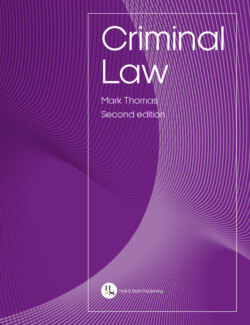Читать книгу Criminal Law - Mark Thomas - Страница 106
Multiple or ‘concurrent’ causes
ОглавлениеThere may be circumstances (as in the above example) where the defendant is not the only cause of harm. More often than not, multiple defendants faced with criminal liability will attempt to pass the blame (see R v Benge (1865) 4 F&F 504). This is often referred to as a ‘cut-throat defence’ and occurs when one defendant blames the other for the end result. Remember from above that the defendant, in order to be liable, need only be ‘more than a minimal’ cause of the end result.
What exactly does ‘more than a minimal’ cause mean though in such a scenario? Goff LJ in R v Pagett (1983) 76 Cr App R 279 reasoned that
the accused’s act need not be the sole cause, or even the main cause, of the victim’s death, it being enough that his act contributed significantly to that result. (emphasis added)
According to the Court of Appeal in R v Hennigan [1971] 3 All ER 133, so long as the defendant’s contribution was ‘substantial’, he could be liable for an offence. The Court did not wish to lay down a precise figure or limit on what conduct would be ‘more than a minimal’; however, the trial judge did suggest that one-fifth of the blame was sufficient to attribute liability to the defendant. Whilst Lord Parker CJ referred to the trial judge’s example of apportioning blame as ‘unfortunate’, the Court did not expressly reject the use of figures to assist a jury. Importantly, this does not mean that if a defendant is less than one-fifth to blame, he will not be considered a substantial cause. In all cases, the defendant must simply be more than merely a negligible or minimal cause. Hennigan was subsequently followed in R v Notman [1994] Crim LR 518 where the Court of Appeal held that anything more than a ‘de minimis’ contribution will suffice. The most recent statement on contribution cases can be found in R v Warburton and Hubbersty [2006] EWCA Crim 627 where Hooper LJ held that:
the test for the jury is a simple one: did the acts for which the Defendant is responsible significantly contribute to the victim’s death.
Figure 2.5Understanding substantial cause
